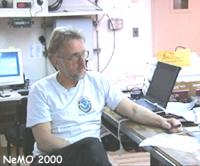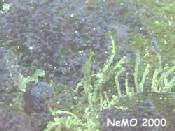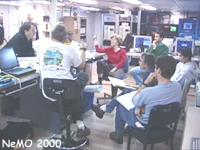| |
Science
Report:
Final Thoughts
on NeMO2000 and the Future of NeMO
Bob Embley, Chief Scientist
We've spent the past 2
weeks exploring the site of a seafloor eruption that happened over two
years ago with a marvelous robot submarine called ROPOS. The area is still
very active, but we have seen evidence at several sites on the 98 lava
flow for a continued cooling off of the vents. However, the caldera of
Axial Volcano sits over a supply of magma delivered from deep within the
earth, so it's likely that there will remain extensive active venting.
Dives with the submersibles
PISCES IV and ALVIN and the ROV ROPOS during the decade before the eruption
revealed such venting on the east side and the ASHES vent field has been
venting for at least 16 years (since its discovery). Although some of
the biological communities were covered over with 98 lavas, their offspring
continue to thrive in the new vents (how they colonize the new vents has
been a focus of several studies on NeMO2000). There is strong evidence
from last year and this year's programs that the system has cooled down
from the high level of activity in 1998 and the volcano may be returning
to some "baseline" of activity.
The suite of samples and
measurements collected during the past three NeMO expeditions tell us
much about the effects of the eruptions on the chemical and biologic systems
but we also need to understand the state of the system "between eruptions".
The microbial community has been shown to be highly diverse during the
past two years. Is this normal or was this diversity stimulated by the
1998 event? Do changes in the microbial and macrofaunal (e.g., tubeworms)
communities correlate with changes in the chemistry of the hydrothermal
system? How long will it be to the next eruption? Will there be signs
of activity building before the eruption? For example, Hawaiian volcanos
gradually "inflate" (as in balloon) for a period of time preceding an
eruption and then "deflate" when magma rises to the surface and is discharged.
The deflation of Axial was measured by a pressure meter during the 1998
eruption and was about 10 feet. This year we've deployed a series of benchmarks
and begun an annual program of precision depth measurements. These measurements,
the bottom pressure meter placed in the center of the caldera, maintenance
of the array of temperature sensors (MTRs and Hobo probes), and the annual
suite of chemical an biological samples will continue to monitor the "state
of the volcano" into the next cycle.
We've accomplished much
on the three NeMO expeditions since 1998 but one of the key questions
still remains. What happens during the first few hours to day of the event?
Certainly, large quantities of heat and hot fluid are expelled from the
seafloor during that period, but we've never been over a site on the Juan
de Fuca Ridge soon enough to capture any of the fluids. The NeMONet technology
is a first step towards placement of an "autonomous" event response system
on Axial. This concept, which is likely to involve an Autonomous Underwater
Vehicle (AUV), is based on having a presence on the top of the volcano
that can communicate with a shore station. If an earthquake swarm is detected,
the AUV would be sent to map and sample the fluids rising out of the site
of the earthquakes. These samples could be held on the AUV until a ship
arrives to collect them days or weeks later. The samples taken so far
suggest that one of our original hypotheses is at least partially correct.
Seafloor eruptions do produce unusual physical and chemical conditions
that stimulate unusual microbial populations. So we continue to strive
to push our ability to study unusual events in one of the most extreme
environments on earth.
The ocean is still largely
unexplored but we know that what we have done at Axial is surely a step
forward in understanding the nature of deep ocean volcanic activity. The
ROPOS group and the ships personnel have made this expedition a great
success for the science party and we thank them for their hard work.
|
|

Chief Scientist
Bob Embley after another successful NeMO expedition.

Mysterious blue stuff near tube worms turned out not to be a protozoan,
but an unidentified organism.

Final scientific meeting
discussing the accomplisments and plans for the future.
|
|

